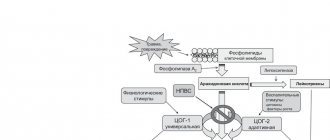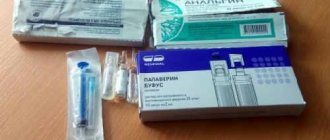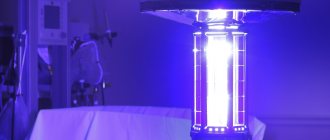Read in this article:
- Types of hypotension
- Causes of secondary hypotension
- Symptoms of low blood pressure
- Consequences of low pressure
- What to do if you have low blood pressure
Blood pressure standards determine the upper permissible limit - 140/90 mmHg, and the lower - 90/60 mmHg. Exceeding these levels is called hypertension. If the pressure is below this range, the condition is considered hypotension or hypotension.
But each person has his own working (normal) pressure, so hypotension is usually called pressure that is 20% lower than the working one.
Types of hypotension
Hypotension can be acute or chronic. With a constant decrease in blood pressure, a diagnosis of hypotension is made.
Acute hypotension develops against the background of heavy bleeding and peritonitis, anaphylactic or traumatic shock, myocardial infarction or pulmonary embolism, as well as an attack of arrhythmia.
Chronic hypotension is divided into several types:
- Physiological – normal. For example, this phenomenon is often found in athletes, since their body is adapted to significant physical activity;
- Primary – associated with overload, physical or mental;
- Secondary – is a consequence of diseases, the development of pathological processes in the body.
Secondary hypotension is most common.
Causes of secondary hypotension
The causes of secondary chronic hypotension may be:
- Anemia, including those associated with blood loss;
- Traumatic brain injuries;
- Intoxication with alcohol, drugs, as well as arising from an overdose of medications or during an infectious lesion;
- Failures in the functioning of the endocrine system, for example. For thyroid pathologies, hypoglycemia;
- For injuries and diseases of the spine - trauma, osteochondrosis, rupture of the vertebral arteries.
Symptoms of low blood pressure
Symptoms of low blood pressure are:
- Dizziness;
- Feeling of weakness up to loss of consciousness;
- Decreased performance, attention, memory;
- Increased heart rate - tachycardia;
- Headache – mainly in the forehead and temples;
- Pain in the heart area that does not stop after 30 minutes;
- Disorders of the gastrointestinal tract in the form of flatulence and nausea, vomiting and constipation.
If signs of low blood pressure appear, it is necessary to identify the cause. For this purpose, various examinations are carried out: ultrasound of the heart, blood vessels, ECG, FGDS. In such a situation, you need to consult a doctor. First, you should contact a therapist, he can refer you to specialized specialists: a gastroenterologist, an endocrinologist, a neurologist.
Inpatient therapy
During a complicated crisis, blood flow to the brain is disrupted, which negatively affects cardiac activity. In the chronic course of such diseases, the patient may experience a stroke or heart attack. This increases the likelihood of death.
If the value approaches 220/120 mmHg, then internal organs may be damaged. After emergency care is provided to the patient, he is sent to the hospital. In its conditions, doctors normalize the indicators using the following injections:
- Clonidine - helps reduce blood pressure by 20% in 2 hours. Over the next 6 hours, the pressure normalizes to the operating limit. The patient feels well.
- Eufilin - restores normal breathing.
- Lasix + Captopril - a complex one-time injection or separate use of these injections every 30 minutes. The dosage is determined based on the patient’s reaction, since the medication can cause nausea and vomiting.
- Relanium - helps relieve muscle spasms. If the patient has been administered triplet, then the dosage of Relanium is reduced.
- Sodium Nitroprusside is administered by drip if high blood pressure is accompanied by clinical signs of heart failure.
A hypertensive crisis can lead to swelling of the brain and lungs. Therefore, the patient is discharged after stable treatment results. According to statistics, 40% of patients are readmitted to the hospital within the first 3 months after hospital treatment.
Pros and cons of injection therapy
The following features characterize the main injections for high blood pressure:
- Furosemide is administered slowly but can cause serious side effects including nephritis.
- Enap - injected slowly. Sometimes it provokes migraines, dry coughs, and allergies.
- Magnesium sulfate - promotes thickening of the airways, can cause apnea.
- Dibazol - used over a long course.
The advantages of the drugs include a drop in pressure within 30 minutes after the injection. All of the above products are characterized by high efficiency. The disadvantages of the injections under consideration include:
- high percentage of adverse reactions;
- against the background of long-term therapy, problems with the liver and kidneys appear;
- The method of administration is considered traumatic, and infection may occur.
Consequences of low pressure
Often a person does not even know that his blood pressure is too high or low. The fact is that the body is able to adapt to changes in blood pressure if they are not critical. There are special internal mechanisms for this. However, low blood pressure can be dangerous.
The consequences of arterial hypertension in many cases are strokes and heart attacks, so people usually pay attention to high blood pressure. But a decrease in the indicator is fraught with no less serious problems.
Low blood pressure in a young person is a significant risk of developing arterial hypotension in adulthood. Hypotension is especially dangerous for older people. Decreased pressure means insufficient supply of oxygen and nutrients to the brain. Against the background of atherosclerosis, this can provoke an ischemic stroke. In addition, with hypotension, diseases such as angina pectoris and atherocardiosclerosis rapidly progress.
Low blood pressure is no less dangerous for pregnant women. The fetus does not receive enough oxygen and nutrients, which leads to the development of birth defects, and sometimes even to premature birth or miscarriage.
What injections are given during inpatient treatment?
Blood pressure parameters 220/120 mm Hg. Art. very dangerous for humans. In this condition, it is important to call a doctor as soon as possible. After a temporary reduction in blood pressure by injection, treatment will continue in a hospital setting.
Drugs used in the hospital:
- Clonidine reduces the readings by 20% in a couple of hours (then blood pressure stabilizes within 6 hours, the patient’s condition improves);
- Eufillin restores the respiratory system;
- Captopril + Lasix are administered in one syringe or separately with a difference of 30 minutes;
- Relanium relieves increased muscle tone;
- Sodium nitroprusside is administered via IV in case of heart failure.
- How to lower low blood pressure at home: folk remedies and medications
A sharp increase in blood pressure in some cases leads to edema of the lungs and brain. When the condition stabilizes after treatment, the patient is discharged. Statistics show that in 40% of cases a person ends up in the hospital again after 3 months.
We recommend reading: Complications of hypertension - what are they?
Injectable drugs to lower blood pressure
Injectable blood pressure medications are divided into diuretics, ACE inhibitors, and peripheral vasodilators. Now more details about each:
- Diuretics help remove excess fluid from the body, lowering blood pressure.
- ACE inhibitors stop the causes of pressure build-up. After administration of the drug, blood pressure decreases slowly. This treatment method is ideal for older people.
- Peripheral vasodilators relieve vasospasm. Used during pregnancy.
After an attack of hypertension, the cardiologist should prescribe the patient further therapy at home.
Papaverine + dibazole
When the tonometer readings become above 180/90 mmHg. Art., the emergency doctor reduces the pressure with a mixture of 2 ml of Papaverine 2% and 3 ml of Dibazol 1%. The medicine is administered intramuscularly, very slowly. The pressure stabilizes after half an hour.
Dibazol has a vasodilating effect. The active ingredient of the drug, bendazole, has the following functions:
- reduces the tone of smooth muscles that form part of the walls of blood vessels;
- normalizes blood circulation.
The drug acts for a short time, there are no side effects.
Papaverine is a vasodilator that reduces muscle tone. The drug is injected into the gluteal muscle. If it is administered intravenously, it can cause a sharp decrease in blood pressure, which the stent causes hypotensive collapse.
- How to properly lower intracranial pressure: drug, surgical and alternative treatment
Magnesium sulfate
Magnesium sulfate is a very painful injection, so it is combined with Novocaine or No-shpa (Drotaverine). It is considered a hot injection for pressure. For administration, a 25% solution is used. Positive effects include removing excess fluid from the body, relieving swelling, improving blood circulation, and dilating blood vessels. An overdose of the drug disrupts the heart rhythm. Rules for therapy:
- the injection is performed using a very thin and long needle;
- you need to warm the ampoule in your palms before use;
- The medicine should be injected very slowly into the gluteal muscle.
Magnesia is one of the popular drugs for lowering blood pressure, as it very quickly returns blood pressure to normal.
Potent drugs
Treatment of hypertension with strong injections is possible only in a hospital setting. Such means include:
- Nitroglycerine. Relieves spasms of smooth muscles, administered through an IV.
- Nicardipine. It has a pronounced hypotensive effect and is administered intravenously by drip. The therapeutic effect is detected after 7 minutes and lasts 20 minutes. Use with caution in case of cardiac ischemia.
- Verapamil. It is administered intravenously and begins to act immediately. It has many contraindications: cardiac pathology, tachycardia, use of β-blockers, lactation period.
- Hydralazine. Administered intravenously, it is effective in hypertensive crisis, a severe stage of hypertension. The positive effect appears after 10 minutes and lasts 10 hours.
- Nifedipine. A vasodilator drug from the group of calcium antagonists, lowers blood pressure. Give no more than 30 mg per day for 3 days. The complex uses diuretics Furosemide, Lasix, Mannitol by drip.
When the drugs are administered, a positive effect is considered to be a decrease in blood pressure by a third of the original figures. In case of an overdose of drugs, severe hypotension may occur.
It is important to remember that injectable medications cannot be used for treatment on their own.
What to do if you have low blood pressure
If the readings on the tonometer are below normal, you need to know exactly what to do if your blood pressure is low. For physiological hypotension, no special measures are required if the person’s well-being remains normal. After reducing physical activity, blood pressure returns to its normal value.
In primary chronic hypotension, the main task is to eliminate the causes of overload, physical and mental. In this case, any methods that promote relaxation are relevant: swimming or massage, long walks. You can supplement your menu with caffeinated drinks, and add cinnamon, cloves or other spices to your food. If all this does not help, you should consult a doctor. You may need to take medications.
Chronic secondary hypotension is eliminated by treating the disease that caused it. Regardless of the type of hypotension, when blood pressure drops, one of the key tasks is to monitor indicators. To do this, the easiest way is to use a home automatic blood pressure monitor in order to notice changes occurring in time and take the necessary measures.
Medicines for high blood pressure
Low blood pressure (hypotension, vegetative-vascular dystonia) is a pathological condition of the body, which is accompanied by a decrease in blood pressure. The cause of the disease is a decrease in muscle tone in the walls of the arteries. What medications increase blood pressure?
Plant adaptogens
Herbal preparations have a mild stimulating effect on the central nervous system and cardiovascular system, help fight drowsiness, physical and mental fatigue, and effectively increase blood pressure. Example of plant adaptogens:
1. Eleutherococcus senticosus extract can be taken together with ascorbic acid.
2. Herbal tinctures:
- Aralia,
- Ginseng,
- Lures,
- Schisandra,
- Rhodiola.
3. Pantocrine is a natural drug in tablet form.
4. Saparal is a medicine based on the roots of Manchurian Aralia.
5. Caffeine in tablet form.
Alpha adrenergic agonists
Drugs in this group are prescribed to patients with orthostatic disorders, hypotensive crises and fainting:
1. Mephentermine is effective for hypotension and orthostatic disorders.
2. Midodrine (Gutron, Midamin) is a medicine for increasing blood pressure that stimulates alpha-adrenergic receptors. The drug constricts blood vessels, preventing stagnation of blood in the veins. As a result, the flow of oxygen to tissues improves, and the volume of circulating blood remains at a constant level.
3. Norepinephrine (Norepinephrine) – solution for intravenous administration. It has an adrenergic stimulating effect and constricts blood vessels. Used for low blood pressure after injuries, poisoning, operations, and cardiogenic shock.
4. Phenylephrine (Mezaton, Irifrin, Vistosan) – solution for injection, acts gently, constricts arterioles. Used for vascular insufficiency and shock conditions.
Drugs to stimulate the nervous system
Drugs that stimulate the central nervous system increase blood pressure, stimulate mental and physical activity, reduce fatigue and drowsiness, increase concentration and improve memory:
1. Adrenomimetics of indirect or combined effects:
- Caffeine sodium benzoate.
2. Analeptic drugs that affect the vasomotor and respiratory centers in the brain:
- Acrinor increases cardiac output without increasing the number of heart contractions, resulting in a sustained and prolonged rise in blood pressure.
- Nicetamide (Cordiamin).
- Symptol is a mild medicine to increase blood pressure.
- Etimizole.
- Effortil (Etilephrine) – constricts blood vessels, increases the volume of circulating blood.
3. Analeptics – drugs acting at the level of the spinal cord:
- Alkaloid.
- Angiotensinamide (Hypertensin) is a drug that is administered intravenously through a dropper. Activates the release of epinephrine and aldosterone.
- Securinin.
4. Anticholinergic drugs:
- Bellaspon,
- Bellataminal is used for disorders of the vagus nerve.
Other drugs
The following drugs are also used to increase blood pressure:
- Heptamil (Heptazol, Heptanal) is a non-toxic, effective medicine in the form of tablets and solution for injection and intramuscular administration. The drug develops the tone of the cardiovascular system and stimulates coronary blood flow.
- Niketamide (Cordiamin, Cordiamid, Tonocard, Cordimid) is an analeptic drug available in the form of drops and injection solutions. Stimulates the central nervous system, stimulates the respiratory and vasomotor centers in the brain. It affects the body in two directions: central and peripheral.
- Citramon is a popular medicine for high blood pressure, containing caffeine, paracetamol and acetylsalicylic acid. The drug thins the blood and has a positive effect on blood circulation, as a result of which the body begins to receive more oxygen.
- Ephedrine is a sympathomimetic drug, available in the form of tablets, nasal drops, and injection solutions. Increases blood glucose concentration and muscle tone, stimulates the central nervous system.
Related products View all products
Aquacitramon, gran.
for oral administration 3 g No. 5 RUB 138.00
More details
Askofen-P, tab. No. 10
31,00 ₽
More details
← Previous article Medicines for lactation
Next article → Medicines for the gallbladder











